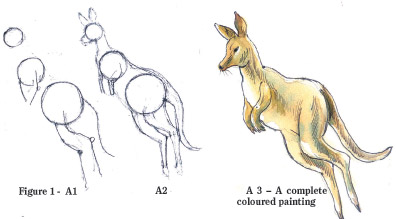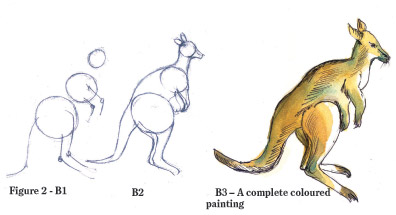|

Painting a kangaroo
 Whatever medium is intended for carrying out a painting, it must
begin with a drawing. A careful study and observation must be carried
out before painting. To teach myself how to draw animals I spent many
hours sketching looking at animals in the Zoo, because that is the
easiest approach to animals than travelling distances to wildlife parks.
Until this study is done, it is good to spend time to get the basic
structure of the animal before painting. Whatever medium is intended for carrying out a painting, it must
begin with a drawing. A careful study and observation must be carried
out before painting. To teach myself how to draw animals I spent many
hours sketching looking at animals in the Zoo, because that is the
easiest approach to animals than travelling distances to wildlife parks.
Until this study is done, it is good to spend time to get the basic
structure of the animal before painting.
Today's lesson is about Kangaroos. They have long, strong tails and
disproportionately large hind legs, and they progress at speed by great
leaps over distances. The kangaroo is an animal from Australia. As in
previous demonstrations in drawing animals on Figure 1, A1 and A2 show
the basic outline drawing. With the help of an HB pencil with a sharp
point start drawing the basic outline structure which will help you to
get the correct formation of the animal. Notice the animal on Figure 1
show starting to leap. The basic outline shown with circles the head,
the chest and body.
 The sketch A3 shows a complete coloured drawing The sketch A3 shows a complete coloured drawing
At first a light wash of burnt sienna is put. Next a dark shaded
colour is added when the first coating is dry. Observe the long ears
pointed up and the kangaroo's eye is added in black just before the
paint gets dry. A mixture of little cobalt blue and yellow Ochore is
added as a final coat to give the correct shading.
On Figure 2. B1 and b2 illustrates a profile in outline. Note the
shape of the body, the basic lines are drawn in circles into three parts
the head, chest and body.
B3 shows a complete painting in colour. At first a pale wash is
applied in burnt sienna mixed with a slight colour of yellow Ochore. A
dark cobalt blue is washed over the wet ground where required. The brown
on the toes of the hind feet, the eyes, the inside of the ears, the nose
and the whiskers are added after the wash is dry. The fine details are
kept to an absolute minimum as these sketches are prepared for children
only. The drawing paper to be used in Whatman or Kent 180 gsm with a
slight grain and brushes sable hair No1 3,4 and 6. |


